@GreenMoms Take On Cosmetics: Safe or Unsafe? And Should We Support the Safe Cosmetics Act?: It’s the Green Moms Carnival!
We’ve got a wonderful round-up of posts from members of the Green Moms Carnival, women who have been following the debate about cosmetics ingredients for years, and have interesting stories to share.
Let’s start off with Diane MacEachern of Big Green Purse. Diane blogs “evidence is emerging that the cumulative use of these products may be contributing to asthma, the onset of puberty in girls as young as three years old, and even the feminization of baby boys. Because cosmetics, soaps and shampoos are washed down the drain, they get into our water system, where they’re wreaking havoc on wildlife. And what about their relationship to breast cancer?”
But Diane doesn’t leave us hanging – she gives three common-sense ways we can reduce our exposure to the potential risks of cumulative exposure to low doses of chemicals.
Beth Terry of Fake Plastic Fish tells the story of why she tried to get away from a cute seat mate on a recent flight. “His Axe cologne, or whatever heinous product he was wearing, made my eyes water, nose itch, throat close up, and left me with a throbbing headache.”
That’s something I’ve experienced as well. Once you stop using synthetic fragrances, it’s hard to even be around them. A walk down a grocery store aisle – or a whiff of last year’s BlogHer room drops – can leave you feeling miserable.
Lisa from Condo Blues recounts an interesting discussion with a research scientist from a personal care company.
“One of the biggest secrets about what chemicals (or not) is in a product is what makes up the product’s fragrance,” she notes. “Last summer, I had the chance to talk to a representative from a large personal care company. She claimed that even her company didn’t know what was in the fragrances of their products because they buy the fragrance from a special fragrance house that has a super secret formula and ironclad nondisclosure agreement that says the fragrance house won’t tell the company what’s in the signature scent of their brand of shampoo.”
Katy at Non-Toxic Kids makes a case for showing The Story of Cosmetics to friends who may be unfamiliar with the battle for safer cosmetics. As she puts it, “Why should you care? There is a growing body of research showing links between many of the chemicals in our personal care products and serious diseases and conditions. Chemicals like triclosan, phthalates, parabens are in most cosmetics. Phthalates are often labeled as “fragrance”. Triclosan is labeled as an “antibacterial.”
And no one is looking at their synergistic effect on our bodies, especially those who are developing and growing at rapid rates: our children. The companies who make these products are using many chemicals that have never been independently tested for safety. That’s right, never.”
Linda from Citizen Green presents a well researched post that follows-up on Katy’s assertion. As Linda blogs, “Only 11 percent of the 10,500 ingredients in personal care products have been assessed for safety by the cosmetics industry.”
And that’s the reason Deanna of Crunchy Chicken blogs, “Make sure you start checking your product labels!”
Karen of Best of Mother Earth pulls no punches when she asks, “How can cosmetic companies like Estee Lauder raise funds for cancer research and produce products with carcinogens in them? Shouldn’t they start in their own back yard and produce a safe cosmetic in the first place?”
I always especially enjoy the contributions of our Carnival members from outside the United States. In Amber’s post at Strocel.com, Story of Cosmetics: Canadian Edition, she blogs about the situation in Canada – how in some ways it parallels the situation in the US, and yet how there are subtle differences. For example, Canadian cosmetic makers are required to list ingredients – “but not all of them.” Huh? So what good does that do? But Amber’s main message is one that is universal:
“But we must recognize that the beauty industry is trying to sell us stuff, just like any other industry that markets consumer goods. They want us to believe that we are flawed and need their stuff. If we aren’t concerned about the state of our skin or the shininess of our hair, we’re not going to shell out for products to fix them. Even initiatives like the Dove Movement are marketing campaigns aimed to make us feel favourable towards a certain brand.
My daughter Hannah is 5 years old. I don’t want her to feel that she needs to coat herself with stuff to be OK, and I especially don’t want the stuff she coats herself with to contain toxins. That’s why I want to see change in the cosmetics industry.”
I always see myself in Micaela’s (aka Mindful Momma’s) posts. Maybe it’s because we have kids around the same age, and while we are passionately committed to living sustainably, too often our lives intersect with the real world of Toys R Us and Pokemon.
In her post, “Maybe I Just Bought the Wrong Stuff,” Micaela blogs, “In The Story of Cosmetics, Annie Leonard comes out and says what a lot of us might be thinking when it comes to buying cosmetics and personal care products: “maybe it’s my fault…maybe I just bought the wrong thing”…meaning it’s our own damn fault for buying personal care products loaded with toxins and petroleum products…because we didn’t take the time to research the hell out of them before we went to the store.
I’m telling you – that is often how I feel. And it’s very frustrating.”
Frustrating? Lisa from Retro Housewife Goes Green goes even farther when she blogs, “I don’t know about you but I’m pissed off at the amount of work I have to do to keep myself and my family safe from cancer causing chemicals. We need to change the whole system and work together to demand safer cosmetics.”
I’m with Lisa – the whole system needs to change, and in my opinion, that includes regulation. But I’m not so sure the Safe Cosmetics Act is the answer. Check my post out here, where I blog about what I’ve learned in two years of following these issues – the things people inside the industry have told me – and my surprise and concern about the backlash opposition to the Safe Cosmetics Act that is being led by small, independent cosmetics makers.
Jennifer Taggert of The Smart Mama (and an attorney) voices her concern that the Safe Cosmetics Act may mean for small businesses. Jennifer has a unique take on this, and her full post is worth a close read. Here’s an excerpt:
“I bring the CPSIA up after watching The Story of Cosmetics because well intentioned legislation can go badly wrong.
That doesn’t mean that I don’t urge you to understand what it is you are buying. To adopt the precautionary principle in your purchasing decisions.
That doesn’t mean that I don’t think we should advocate for sensible legislation and regulations.
But that’s it – the legislation and/or regulations must be sensible. And that is hard to do. The devil is in the details. Overbroad legislation has unintended consequences and collateral damage.
As said by Supreme Court Justice Louis Brandeis:
The greatest dangers to liberty lurk in insidious encroachment by men of zeal, well-meaning but without understanding.”
What do you think?
Leave a comment and let us know!
And did you know you can get ALL of our posts pushed out to you via Twitter? Just follow us here: http://www.twitter.com/GreenMoms
— Lynn
Copyright 2010 OrganicMania
A Day In The Life: When Advocating for Green Is Easier Than Being Green
I was amused last week when I saw these tweets from a California conference. “Green is Mainstream.” “It’s not a differentiator.” “It’s just what everyone does.”
Really? Maybe I need another trip to California. (But of course, that wouldn’t be too green.)
For this month’s Green Moms’ Carnival, Beth of Fake Plastic Fish challenged the Green Moms to write about a “Day in the Life,” reflecting on the “green steps we take as well as the green challenges we face and the hard decisions we have to make.”
As luck would have it, I chose a day that ended up revealing a sad truth: sometimes it’s easier to advocate for green than to be green. Does that make me a hypocrite? Or does it just show how much more work we have to do before being green in Maryland is as easy as being green in California?
But back to my day….It was Wednesday, June 9th, cloudy and overcast, and threatening showers as I closed the front door. I was heading out to the Bethesda Green Incubator, where my business is located. I was on time (mindful that running late invariably results in taking the car instead of walking), ready for an easy 15 minute walk.
But I hesitated.
The sky was dark. What if it rained? I had my laptop, after all. I wouldn’t want that to get soaked, would I? I debated. I thought about Beth. I thought about the Carnival. I thought about water seeping through my bag, damaging my laptop. The minutes crept away. I was on the verge of being late. I took the car. It’s not a Hybrid. It consumes oil, the very kind that’s seeping into the Gulf.
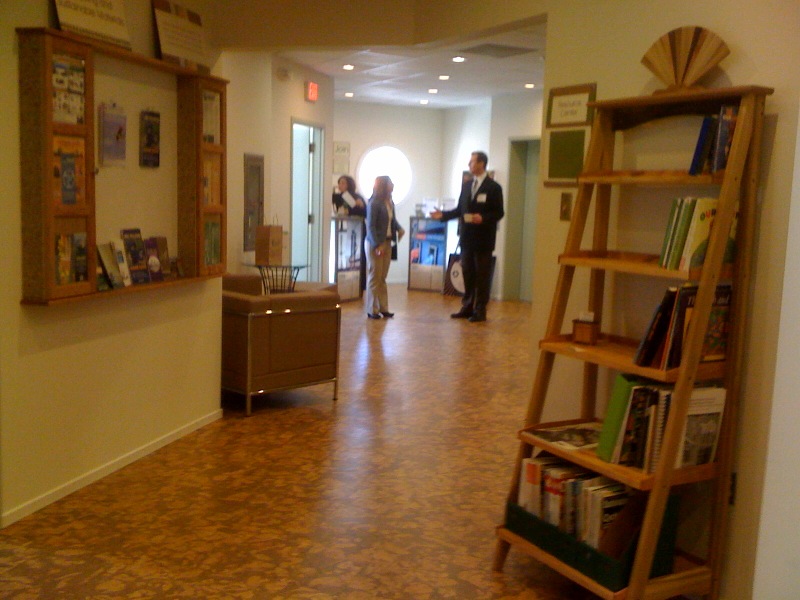
At the Incubator, I walked out to our model-green reception area to meet Ariana Kelly, a Moms Rising advocate and candidate for the Maryland State House.
I told her the Bethesda Green story: how the community came together – business, government, and residents – to take on volunteer projects to make our community more sustainable. I pointed out the cork floors, the low VoC paints, the rain barrel displays, the permaculture exhibit, specimen seed library, and solar panels.
Then we walked across the street for lunch (so far, so good) and ate a lunch that assuredly was not sustainable. (After all, when it’s sustainably raised seafood they charge more for it and advertise it as such, don’t they?) At least our conversation was green. We talked about all that Maryland was doing with B Corp legislation and the BPA ban, and the Bethesda Green Business Delegation that met in Annapolis recently.
Then I ran out to retrieve my car, soon discovering the day’s first stroke of Bad Green Karma. A parking ticket.I should have walked. Not a drop of rain fell from the sky. And now I owed $40. My lunch had suddenly became quite expensive.
Later that afternoon, I picked Boo up from preschool, wincing as he carried some Pepperidge Farm goldfish in a plastic cup out the door. Every day, I dutifully packed reusable containers. Couldn’t they be used to pack up snacks?, I wondered. Must remember to bring that up to the teachers, I thought, as I dashed out the door to my car (yet again). After all, we had to hurry to make it to the CSA pick-up, and then on to the end-of-year Cub Scout picnic.
Soon, I stood at the CSA, hurriedly weighing the fresh-picked biodynamic and organic produce. Scallions? Check. Apples? Natch. Radishes, swiss chard, kale, fresh-baked bread, lettuce, they all went into my re-usable bag.
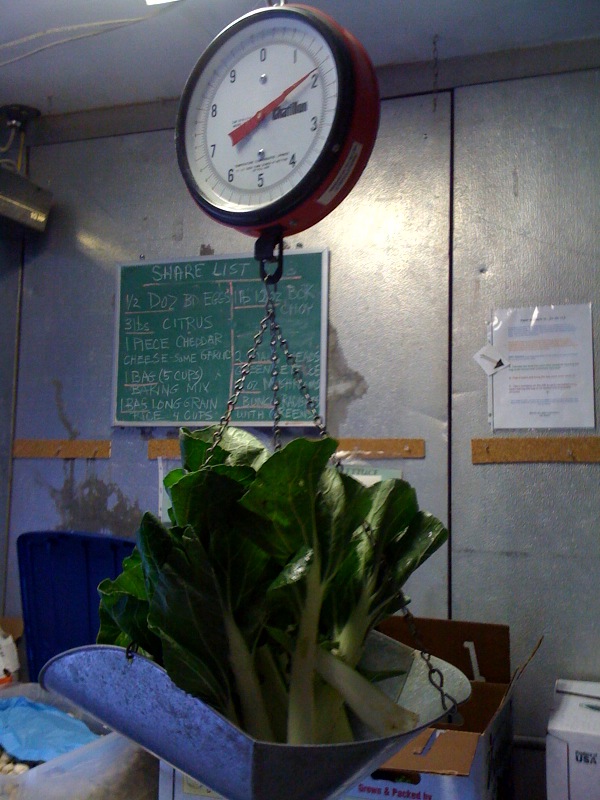
I heard Boo fussing, and asked him to be patient and wait for Mommy. I was in a hurry, after all, and there were four people behind me, waiting to use the scale.
Then I heard it.
CRASH.
Tiny bits of crushed Pepperidge Farm goldfish – all over the pristine garage floor of the CSA. Ev eryone froze, looked at Boo, and then looked at me. I sighed and said, “That’s what happens when you dare to bring Pepperidge Farm goldfish to a biodynamic CSA. God strikes you down.”
After the laughter died down, a broom appeared, everything was swept up, and we were off on our way to the picnic.
I was in such a hurry, I didn’t bother to check directions before I left the house. And my in-car navigator (Big Boy) wasn’t with me….he had left ahead of time with his friends and their Mom. So I overshot the park. Sat, idling (burning more of that fuel) in front of an apartment building 1 /4 mile from the turn-off for the park, frantically navigating my iPhone, trying to figure out where I was supposed to be.
(Maybe at this point I should mention my DH was on Day Seven of an extended business trip. The one where he gets to hang out in a castle by the Mediterranean Sea. And I was spent from playing Single Mom for a week).
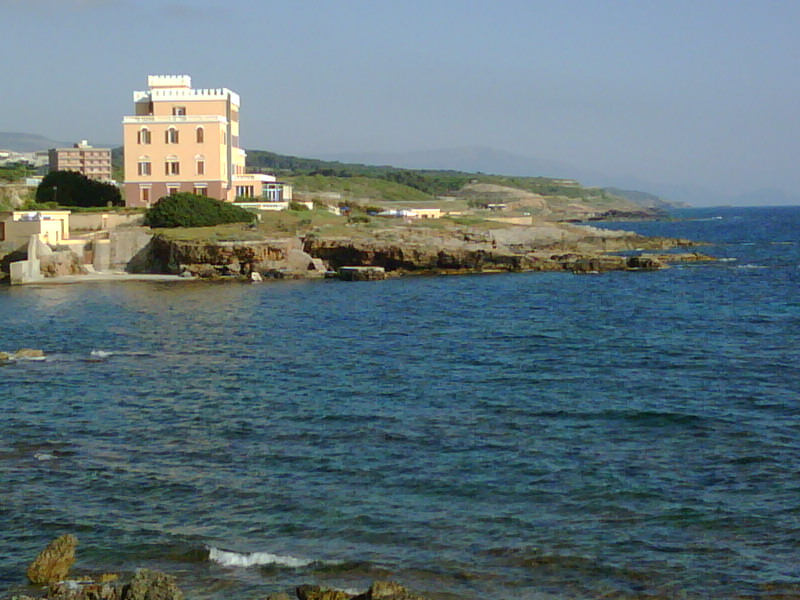
Finally, we arrived at the picnic, eager to partake in the festivities. I frowned at the hot dogs and hamburgers, thinking of the heavy burden conventional farming techniques, especially those used to rear cattle and pork, place on our ecosystem. I helped myself to some salad, trying to ignore Boo’s pleas for a hotdog or hamburger, before finally giving in. Their father, the committed vegetarian, was out of town. And we so rarely had meat. They even had a grill! I ended up eating some myself.
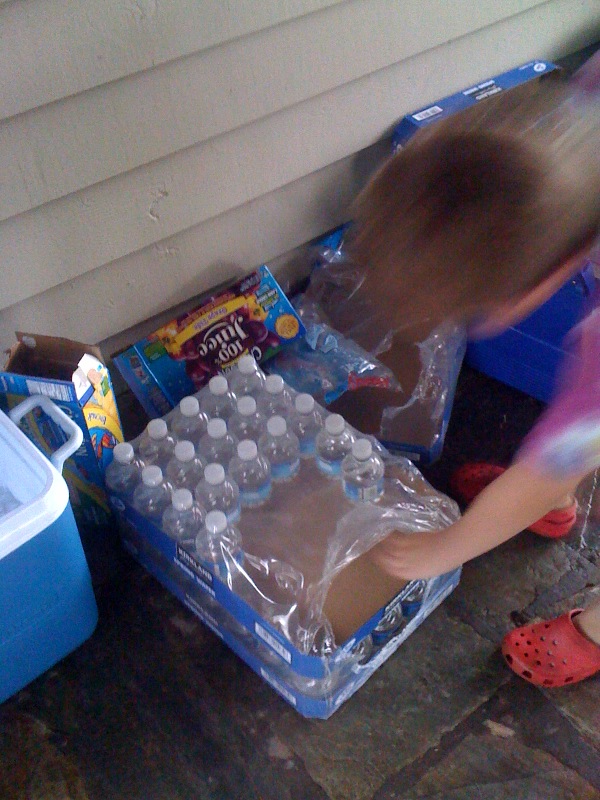
But the bottled water? That was just beyond the pale. I hurried out to my car to retrieve my stainless steel water bottle. At least I had remembered that! When I returned, my friend smirked and asked me to look closely at the bottled water. They weren’t drinking water, she said.
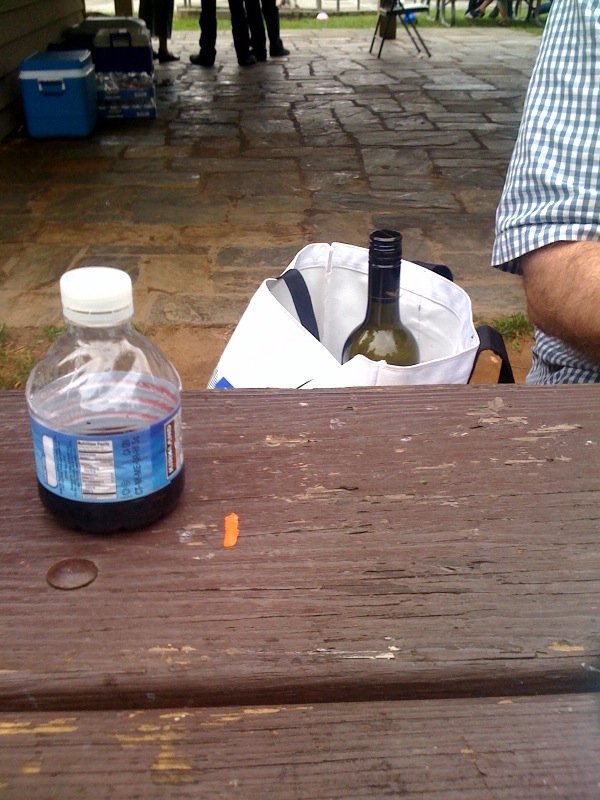
I burst out laughing. Cub Scout parents surreptitiously drinking wine from empty water bottles? It brought back memories of alcohol snuck into parties when I was under-age. It was too funny. I had to have some! (Just on general principle!) But how? I only had my water bottle, and Boo needed some water. My not-so-green friend eyed me, amusedly. She knew exactly the calculation I was making.
“I’m not touching those plastic bottles!” I hissed.
I asked Boo if he wanted some more water.
“No, I’m fine,” he told me.
“Drink up, “ I urged. “There won’t be any more water.”
“I’M FINE!!!”
I dumped the rest of the water out of my re-usable water bottle and smiled contentedly as her husband filled it part way with the red wine. It wasn’t that good, actually, but it was the absurdity of the situation that made it worthwhile.

“Mama, can I have some more water?”
That’s when I gave up and opened one of those darn plastic water bottles.
(And made a mental note to see if we couldn’t procure some large water jugs for the next Cub Scout picnic.)
And decided that I had more than enough material for a decent “Day in the Life” post.
Easy to be green? Maybe in California. But not where I live.
What about you?
— Lynn
Copyright OrganicMania 2010
Filed under Bethesda, CSAs, Green Ideas & Stuff, Green moms, Green Moms Carnival Home Page & Calendar | Wordpress Comments (15) |Thinking Again About a Hybrid or Electric Car? You’re Not the Only One
It seems like an eternity ago that decisions to purchase hybrid and electric vehicles hinged mainly on considerations like fuel economy, the price at the pump, and the age and condition of your existing car.
The Gulf oil spill disaster changed all that.
Nothing in recent memory has so powerfully seared into our collective consciousness the need to reduce our dependence on oil.
Wildlife is dying.
The ocean is suffering.
Read this moving blog post by Larry Schweiger, President of The National Wildlife Federation.
Nothing will ever be the same again.
With this as the backdrop, I hate to confess, I have my own oil addiction. I don’t own a hybrid. One of our Subarus is eleven-years-old, and still in excellent condition. Our other Subaru is newer, and we bought it out of brand loyalty – the first one kept us safe after a deer crashed into our windshield when I was pregnant with Boo.
Subaru, when are you introducing hybrids or electric vehicles?
I’m in the market for a hybrid or electric car now. (Guess I should have really made the Volt test drive that Chevy invited me to!)
What about you?
This is a post for the Green Moms Carnival on Transportation, hosted by Big Green Purse.
— Lynn
Copyright OrganicMania 2010
Filed under Product Recommendations, Uncategorized | Wordpress Comments (12) |The Hypocrisy of Cancer
“Thank God for those writers, activists, and demonstrators who have the courage to dig around in the manure and expose hypocrisy,” my rector said this morning from the pulpit.
That was it!
I could have blogged about my contempt for pinkwashing, defined here as “the term used to describe the activities of companies and groups that position themselves as leaders in the struggle to eradicate breast cancer while engaging in practices that may be contributing to rising rates of the disease.” Or I could have asked why the many environmental links to cancer are not more widely acknowledged in our society.
But then again, why did I want to risk being pegged yet again as just one of those “hysterical Mommy bloggers?”
Sadly, many people shrug off cancer, perhaps as a means of coping with the fear of this horrible disease. “Everything causes cancer!,” they’ll joke. “We can’t live in bubble wrap,” they’ll say.
It doesn’t have to be this way. If we would only clean up our environment, ban known carcinogens from use in our personal care products and household cleansers, and prevent exterminators from spraying pesticides inside homes, we’d be well on our way to reducing and preventing the increasing numbers of breast cancers.
Don’t just take it from me. Listen to what these experts say about environmental linkages to cancer. And please check out the round-up of posts on this topic from the other members of the Green Moms Carnival. Among them are some experts as well. We’re posting Monday over at Nature Moms.
- The Breast Cancer Fund: “No more than 10 percent of breast cancers are genetic, and science points to toxic chemicals and radiation as factors in the sharp rise of breast cancer incidence.”
- Dr. Devra Lee Davis and the Environmental Health Trust. Dr. Davis says, “We should…find safer substitutes for the things we use every day that appear to be toxic, according to their labels…For nearly a century, the following things have been understood to cause cancer: tobacco, benzene, asbestos, tars, sunlight, hormones, and radiation.”
To be kept informed of the latest developments in the fight against cancer-causing environmental contaminants, follow these groups:
- Healthy Child, Healthy World
- Campaign for Safe Cosmetics
- Environmental Working Group
- Safer Chemicals, Healthy Families
- Breast Cancer Action
— Lynn
Copyright OrganicMania 2010
Filed under Cancer | Wordpress Comments (11) |The Green Moms Take on Environmental Links to Cancer
Next Monday the Green Moms Carnival members will host our 26th carnival. We’ll tackle environmental links (or causes, depending on your perspective) to cancer. I’ll admit I’ve become radicalized about this subject. Despite all the talking about “finding a cure for cancer,” we actually are a lot closer to knowing what causes many cancers than the mainstream public believes. If we cleaned up our environment and took the toxins out of the products we use everyday, I believe we’d find that our cancer rates would dramatically decrease.
.

My very first post here at OrganicMania was about cancer, and that was before I was aware of the many environmental links to cancer. Cancer is a subject that’s close to my heart, having two parents who battled cancer – my mother successfully, and my father unsuccessfully. I also lost my mother-in-law to the disease, and many other cousins, aunts and uncles.
Cancer is a subject I’ve wanted to revisit, and that’s why I asked Tiffany of Nature Moms if she’d host this carnival. Most of us know Tiffany as one of the trailblazers in “green mom” blogging. But Tiffany is also a young woman who battled cancer in her 20s. Her experience caused her to examine the environmental causes of cancer. I couldn’t think of a better host for this carnival.
If you’d like to contribute a post to the carnival, it’s not too late. Just include a link to Nature Moms, to the home page of the Green Moms Carnival, and email your submission to greenmomscarnival at gmail dot com by Sunday morning.
We’re going to be talking pinkwashing, carcinogens, plastics, coal, household cleansers, you name it….we’ll put it on the line.
Join us. Monday at Nature Moms.
— Lynn
Copyright OrganicMania 2010
Filed under Uncategorized | Wordpress Comments (2) |Coal: Can’t We Do Better?
Lisa was right when she said this month’s Green Moms Carnival topic would challenge us. Coal. It’s one of those things most of us take for granted. We don’t really think about coal – where it comes from, what it does, why we depend on it. Oh sure, we think about climate change. We blog about climate change. But climate change is a topic that’s front and center in the media and the blogosphere. We think about the ramifications of climate change: rising sea levels, economic destabilization, melting polar ice caps and so on…
When I stopped and thought about it, I realized I knew very little about coal besides the fact that it accounted for most of our energy use in this country, was a main contributor to global warming, and made up a very dangerous life style for the coal miners in West Virginia, Pennsylvania, Ohio, and elsewhere. Oh, and when I was exposed to it for the first time via our family trip to see Thomas the Tank Engine, I coughed and coughed and coughed…


So I went straight to the US Department of Energy website, where I learned:
Coal is one of the true measures of the energy strength of the United States. One quarter of the world’s coal reserves are found within the United States, and the energy content of the nation’s coal resources exceeds that of all the world’s known recoverable oil.
The text pretty quickly jumped into an explanation of all that the DoE is doing to try to counter-balance the negative impacts of coal. “Innovative, low-cost environmental compliance technologies and efficiency-boosting innovations are being developed by the Energy Department’s Fossil Energy research program.
To tap the full potential of the nation’s enormous coal supplies, the U.S. Department of Energy’s Office of Fossil Energy is working with the private sector to develop innovative technologies for an emission-free coal plant of the future.
This research and development program is pioneering more effective pollution controls for existing coal-fired power plants and an array of new technologies that would eliminate air and water pollutants from the next generation of power plants. Research is also underway to capture the greenhouse gases emitted by coal plants and prevent them from entering the atmosphere.”
Let’s face it. Coal is dirty. “Clean coal” is a dream, not yet proven and with unforeseen consequences for our groundwater supplies.
More people have probably died from coal – from the toxic pollution it spews into our air and our water – than from both world wars and the 1918 influenza combined.
Coal is destroying our landscape too. Mountain top removal means exactly what it sounds like. It’s horrible. And it’s irreversible.
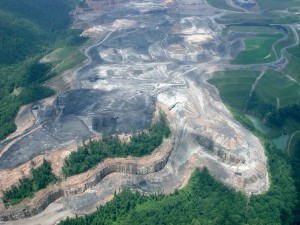
Can’t we do better than coal?
An entirely new, clean green economy is looking for investment, looking for opportunities to prove what it can do to make our nation more energy-independent and cleaner and greener. Solar. Wind. Hydrothermal. Even, dare I say, nuclear and natural gas – these are the way of the future.
Check out the other posts at the Green Moms Carnival on Coal, hosted today by Retro Housewife Goes Green.
— Lynn
Copyright OrganicMania 2010
Filed under global warming | Wordpress Comment (1) |Another Green Moms Carnival on Wednesday: Conserving Resources

Interested in contributing a post to the next Green Moms Carnival? Micaela of Mindful Momma is hosting on Wednesday, so here’s your chance to get a post in to her (quickly!) about Conserving Resources. Please send it in to greenmomscarnival at gmail dot com.
Remember, we can’t guarantee that all submissions will be accepted. Read more about carnival submission guidelines here.
Thanks and have a great week!
Gotta go now and work on that post! 
— Lynn
Filed under Uncategorized | Wordpress Comment (0) |Green Schools: Five Lessons Learned the Hard Way
Editor’s Note: This post is for the Green Moms Carnival on Green Schools, which will appear here at OrganicMania on Tuesday, August 11th. There will be great contributions from green women bloggers from all around the country, weighing in on green schools – from nursery school to college!
It seems like just yesterday that I squeezed into a seat at the kid-size cafeteria tables at my son’s new elementary school. I was there to participate in my very first PTA meeting, and while I was interested in many of the things going on at the school, what I really wanted to learn about were the school’s environmental initiatives. I wanted to get involved in the Green Committee.
Imagine my surprise when the PTA leadership didn’t seem to understand what I was talking about. They invited me to become involved with the committee that watered the trees over the summer. Oh, and they really wanted some help with a children’s garden.
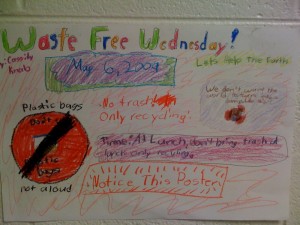
But I’m not much of a gardener. I may feel green, but my plants are brown. I wanted to focus on environmental issues like substituting conventional school cleaning products with more environmentally friendly options; introducing waste-free lunches; eliminating the throw-away styrofoam trays used in our lunchroom; replacing Sally Foster fundraisers with more eco-friendly options; and stopping the Cheap Plastic Crap giveaways used at school fundraisers. And that was just for starters! Then I could see moving on to including walkable schools in our County and State Carbon Reduction Programs, retrofitting the school with solar or wind power, and more…
I think the other committee members went into overload just listening to my wish list. Our principal suggested that the new parents hold back and watch and learn what went on at the school instead of jumping in with a million new directions. So I did what comes unnaturally to this Jersey girl: I shut my mouth.
After the meeting, several other of the incoming parents approached me and said they understood and supported what I was proposing, and would be glad to help. The problem was that no one wanted to lead the effort. No one could seem to find the time. I agreed to co-chair a committee, but soon found that coordinating with a co-chair and getting the committee off the ground fell by the wayside as I focused more of my energy on work, home, family, other volunteer work, OrganicMania, and the Green Moms Carnival.
I blogged a bit about my Green Mom Culture Shock during this time and how I was Dealing with the Schools: Coping as a Green Mom…but then I went all quiet on you. Didn’t say too much about what was going on…
So did we make progress this last school year? Yes, but not nearly as much as I would have liked. I did learn a few lessons, though, which I’m happy to share with other eager parents as they seek to navigate the new world of PTAs and public schools. What about you? What’s worked for you? Please leave a message and share, because the new school year is about to start up and we can all learn from each others’ experiences. What’s worked for you as you’ve sought to green your school?
Lesson #1: Meet People Where They Are
Only months after that first meeting did I learn that the existing gardening committee had plenty of “greenies” involved who would have been happy to take on many of the other issues I proposed. And had I volunteered first with that committee, proved myself, and learned how things worked at the school, our Green Committee probably would have had more impact.
Lesson #2 Get Support from Area Non-Profits
Through the Green Schools committee of my town’s sustainable communities initiative, Bethesda Green, I learned that the Audobon Society’s Green Schools Initiative was trying to reduce waste at my son’s school. Several of the other committee members were from my son’s school, and we were encouraged us to go back and try again with the Green Committee, or just to do things on our own as we could fit them in. The woman who led the charge? Probably the busiest one among us – she has triplets!
Lesson #3 Seek out Liked Minded Allies in the School Early On
Through the Green Schools committee, I met a teacher from my son’s school. She was able to shed some light on mysteries like WHY the class buying lists contained so many plastic items, and how to get that changed for the next school year.
She was also able to explain that there were a bunch of different Green initiatives going on at school that would have more reach and impact if they were coordinated. Coincidentally, I heard the same thing from the PTA president at that time. Soon we were able to get things a bit better organized, and on much sounder footing for this coming school year.
Having friends “on the inside” of the school really helps!
Lesson #4 Connect with other Local Schools and Learn What’s Worked There
Some of the other schools here in Bethesda, Maryland have had far greater participation in their “Waste-Free Wednesday” lunch campaigns than we did with ours. It may just take time for new ideas to take root, but it would have been ideal if we could have touched base with the green leaders at our town’s other schools to see how they achieved so much success. Thanks to our community-wide Green Schools initiative, we’ll be connecting with those other green school leaders soon.
Lesson #5 Propose Well Thought-Out Alternatives
It’s not enough to say, “Get rid of the traditional school fundraising programs and all of the “stuff” that they push on people!” When well established fund raising programs are bringing in $20K or so for the PTA, you’ve got to have a plan to replace that money. There are many new green school fundraising programs emerging, but how much money are schools actually making from these programs? That’s one question I haven’t yet been able to answer to our PTA’s satisfaction. (Perhaps a kind reader will leave a comment here with that information!)
What about you? What’s worked and what hasn’t worked as you’ve sought to “green” your neighborhood schools? Please leave comment and share!
Lynn
Copyright OrganicMania 2009
Filed under Bethesda, Green Charities, Green Ideas & Stuff, Green moms, Green Moms Carnival Home Page & Calendar, Green Schools, School lunches, Tips | Wordpress Comments (12) |How to Pack A Cheap and Easy Waste-Free Lunch
There are many eco-friendly options available for school lunch, but let’s face it: most of them are still pretty pricey. Shelling out $21 for a Sigg water bottle or $37.95 for a Laptop lunch box adds up to big bucks quickly.
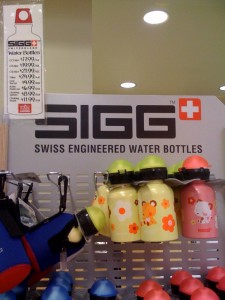
The very popular Sigg bottles range in price from $17.99 to $24.99 at this Bethesda Whole Foods.
Here are five super cheap, easy ways you can send your kids back-to-school with an eco-friendly lunch bag. If you’re fortunate enough to have what you need already, maybe you could take this post and send it to a school list serv or to others who might find this information helpful.
There are really just five things you need for a waste-free lunch:
1. Lunch box – or brown bag. While there are great eco-friendly lunch box options out there, most range from $14 on up. You can buy a pack of 100 brown paper lunch bags for $1.99. No, it’s not totally waste-free, but most municipalities recycle paper – so you can toss the bag out with the newspapers to be recycled! It’s a much more environmentally friendly option than buying a conventional school lunch bag, which are often made of PVC plastic. Read here to learn why you want to avoid PVC, which is harmful to our health and to the environment.
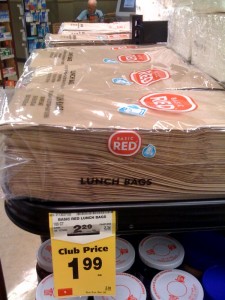
As seen in a Bethesda Safeway, buy 2 packages for $3.98 and you'll have enough recyclable brown bags for the entire school year.
2. Water bottles. This is a biggie. Visit nearly any school cafeteria and you’ll see a staggering amount of waste from disposable juice boxes and milk containers. Yet most stainless or non-PVC water bottles are $10 and up – some as high as $25 or more. Before I invested in two Sigg Mr. Sharky’s (pictured below), I used a good ole Honest Tea bottle. Made of durable glass, it was fine for drinks on the go. I still use one in a pinch!
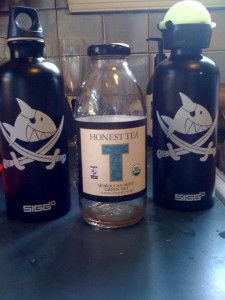
A durable glass bottle, such as this Honest Tea bottle, can be reused as an on-the-go water bottle.
3. Cloth napkin. No need to buy new here. Pretty much everyone has a spare dish rag or dish towel lying around the house, or some “good” cloth napkins that are only taken out for “special occasions.” These are perfect for school lunch. So far, my son hasn’t asked why he carries a linen dishcloth with a 1977 calendar on it, but I’m sure that day is coming soon…!
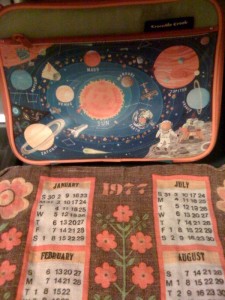
Yes, that's my mother's calendar dish towel from 1977, now doubling as a napkin in my son's lunch box. Do I get a Reduce, Reuse, Recycle, Refuse award for this?
4. Food containers. My how things have changed just in the past year. Now you can buy stainless steel containers for school lunch. But again, cost is an issue. If you don’t want to spend $40 for an all-in-one lunch kit or $16 for a stainless steel food container, you can go the el cheapo route like I did.
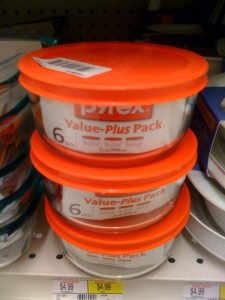
Three of these glass Pyrex food storage units sell for just $4.99 at a Bethesda Giant Food store.
Unfortunately there are no more of these nifty $4.99 glass pyrex containers at the Bethesda Giant, because I bought out their entire stock!
And here’s a shot of Big Boy with his lunch bag, which contains some plastic (gasp) Gerber food containers. I love these. They’re made in the good old USA, they’re cheap (under $5 for 4 small dishes) and they’re made of #5 plastic, which does not contain BPA. Still, to be on the safe side (because all plastics can leach) I keep these plastic bowls out of the dishwasher and the microwave I had to search high and low for these – they seem to sell out as soon as they’re in stock, but you can sometimes find them at Target or Buy Buy Baby.
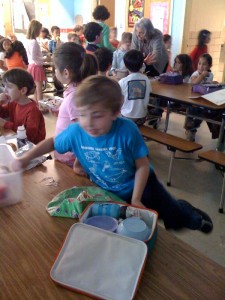
He’s also carrying a more traditional “Green Mom” accoutrement – a Wrap n’ Mat sandwich wrap, which is made of washable cloth and durable, low density polyethylene (LDPE). These sell for $7.99 on the Internet, but I bought mine locally at My Organic Market. When I hit the Wrap n’ Mat website as I was writing this post, I learned that they’ve just introduced little snack pouches, which sell for $8.99 each.
5. Cutlery. This past school year I packed lunches with our regular cutlery, and unfortunately I regret it because some of our silverware never made it home. This year I’m trying Sporks !
And I leave you with a picture of my boys’ trusty Crocodile Creek lunch bags being cleaned out. Because this frugal green Mom isn’t planning to buy new ones this year!
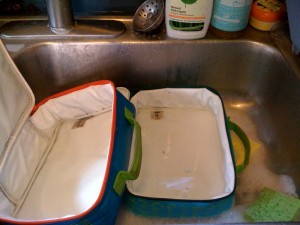
This post is for the Green Moms Carnival: Green Schools Edition, which runs tomorrow (Monday, August 10th) right here at OrganicMania.
— Copyright 2009 OrganicMania
Filed under Bethesda, Food, Giant, Green moms, Green Schools, My Organic Market, Product Recommendations, Savings Tips, School lunches, Sustainable Packaging, Tips, Whole Foods | Wordpress Comments (13) |Green Moms Carnival Is Up!

This month’s Green Moms Carnival is about Food. Food Matters. Of course it does. We all depend on a steady supply of healthy, nutritious foods. I wish all of our food could come from places like the beautiful, certified-humane organic Ayrshire Farm, pictured above. I snapped this photo on Monday while touring the picturesque 1,000 acre farm in Upperville, Virginia.
Check out the posts over at A Passion for Green Business. I guarantee you’ll learn a lot about why Food Matters.
— Lynn
Filed under Food, Green moms, Organic Prices | Wordpress Comment (0) |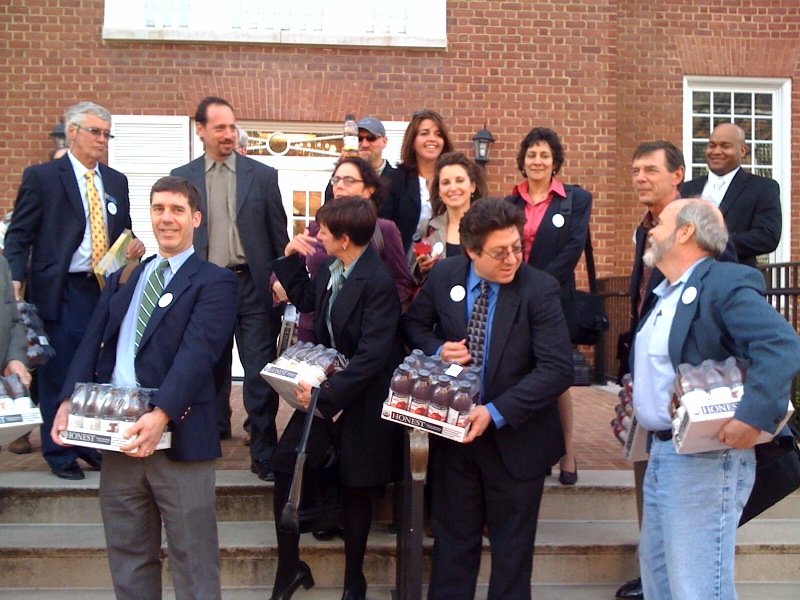
 My StumbleUpon Page
My StumbleUpon Page



